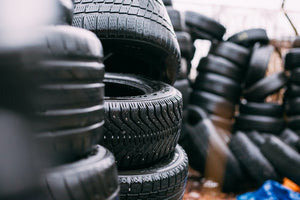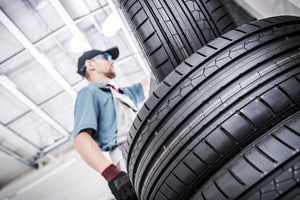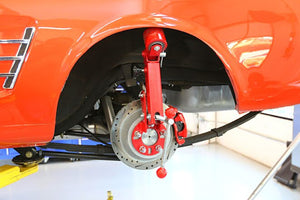
Grip for Days: What Tires Work Best on the Track
If you’ve read some of our previous articles, then you’re probably part of a community of car enthusiasts; and you’re probably also planning to buy a new set of wheels in the near future. Mazel tov!

It’s important to note that often your standard tires won’t fit if you buy new wheels, so surprise, surprise, you need new tires.
As car enthusiasts, we have a connection with our vehicles that non-enthusiasts have a hard time understanding. We don’t merely use our vehicles as a means of transportation; we actually like driving our cars, and that means we also like driving our cars fast.
Of course one cannot drive like Cannonballer Brock Yates on crowded streets and highways: there is a place and time for fast driving, and that’s not on the I-50 just past midnight or on a city street packed with pedestrians. No, the appropriate time and place would be at your local racetrack on a clear day – with your friends, and with like-minded enthusiasts.
A good reason to take your car to the track is to test the limits of what your car can do. And for those who drive stock cars, one of the first things you realize is that your standard tires weren’t designed to corner hard. So, after buying your new aftermarket wheels, you need to wrap them in grippier, more sport-oriented tires.
Deciding what tires to buy

There are many tire manufacturers that cater to the car community. We have industry mainstays, such as Michelin, Bridgestone, Dunlop, and Pirelli, and more value-oriented brands, such as Federal, Goodyear, and Yokohama. Some of these brands, which have been around for the better part of a century, have built a superb reputation in the car industry.
There are also brands that have risen to challenge these name brands. Brands such as Hankook, Nankang, and Sailun attract their customers by offering affordable tires. Despite the affordable price, these brands produce high-quality tires that are even used to compete in motorsports.
While it’s prudent to choose tires based on their reputations, your budget will also play a big part in the tires you choose. It wouldn’t make sense to buy a set of wheels for the track if you’re only going to use them once a year; but, at the same time, if you’re a track buff, a reliable set of tires is always a good investment.
In this article, we distinguish between high-value tires and low-value tires in order to give you a clear idea of what’s available in the sports car market.
Hankook Ventus RS4

Price: $600 - $1,300 per set of 4
Hankook is a South Korean tire brand that was founded in 1941. Since its inception, it has grown into a global brand by producing high-quality, affordable tires. They even manufacture OEM tires for several car companies.
One of their best tires for the track-oriented driver is the Ventus RS4. These tires have a treadwear rating of 200, putting them well in the realm of the amateur racing tire.

They also come in a range of sizes, fitting wheels with rim diameters from 15” to 19”; their attractive tread design also makes them aesthetically pleasing.
User reviews rank the Ventus RS4 quite high; the reviewers were particularly impressed by their performance on the track.
The RS4 offers an impressive mix of road and track driving capabilities that make it a close rival to the more established tire brands.

__
Nankang NS2-R

Price: $600 - $1,300 per set of 4
The Nankang Rubber Tire Corporation was founded in Taiwan in February of 1959. With so many years of experience, it’s no small wonder that Nankang is a premier brand, rivaling even established brands when it comes to brand recognition.
While the likes of Michelin and Pirelli still reign supreme in America, Nankang is extremely popular in its home market of Asia, offering affordable, high-quality tires at affordable prices.

The NS2-R is one of their most popular high-performance tires; it has a treadwear rating of 200.
It comes in a variety of sizes. For this reason, the NS2-R suits nearly every car, except perhaps the Lamborghini Countach, which still holds the record for the widest tires ever fitted to a road car.

__
BFGoodrich G-FORCE Sport COMP. 2

Price: $770 - $910 per set of 4
Founded in 1852, BFGoodrich is one of the oldest tire companies in the world. With over 150 years of experience in tire manufacturing, they’re the gold standard for tires. Consistently ranked as one of the best tires when it comes to quality, durability, and affordability, BFGoodrich reflects the American tire industry’s commitment to excellence.
Their G-FORCE Sport COMP. 2 is one of their best tires. With a treadwear rating of 340, one might assume that it is an inferior tire for track racing; but the reviewers rank it high in this department as well.

Amateur racers who regularly use these tires claim they grip the road well and are durable; they also handle wet tracks well.
Unfortunately, the G-FORCE Sport COMP-2 only comes in a few sizes — from 18” to 21”. Thus, they won’t fit cars with smaller wheels.

__
Goodyear Eagle F1 Asymmetric 2

Price: $565 - $1,885 per set of 4
Moving into the more expensive tires on our list, we reach the Goodyear Eagle F1 Asymmetric. Quite a mouthful, isn’t it?
Goodyear’s 123 years in the tire business has given them a wealth of knowledge regarding how to manufacture the perfect tire. It has also enabled them to become one of Formula 1’s most popular tire suppliers, along with brands like Bridgestone and Dunlop.
The culmination of that experience and technological research led to the formation of the Eagle F1 series. This includes the Asymmetric 2, which is one of their most versatile tires.

With a treadwear rating of 240TW, the Eagle F1 Asymmetric 2 gives users great traction on dry tracks; it is also durable and maintains its handling capabilities even when it gets too hot.
The downside is that the tire doesn’t perform well on wet tracks, but since all performance aspects take a hit in the rain, it’s not entirely the tire’s fault.
The Eagle F1 Asymmetric is also made for larger wheels. So, like the BFGoodrich G-FORCE Sport Comp-2, it will not fit wheels smaller than 18”.

__
Yokohama Advan Neova AD08R

Price: $740 - $1,754 per set of 4
Founded during World War 1, Japan-based Yokohama Rubber Company has set the car scene ablaze with the Advan Neova AD08R. The Advan Neova performs exceptionally well on the track; but that’s not the only reason for its popularity. The AD08R is also a great street tire.
Normally, buying tires is a casual affair, but in the case of the AD08R, fitting it to your ride affords you a certain amount of street cred. That's because the AD08R has a stellar reputation as a track tire.
Although some of the people who buy AD08Rs don't go to the track often, they'll still feel the potential of these tires on the streets. Added bonus: They look great on just about any kind of car.

In addition to providing superior grip, the AD08R’s 200TW comes in a variety of sizes. Unlike other tires in this price bracket, the Advan Neova AD08R fits wheels from 15” to 19”.

__
Michelin Pilot Sport 4S

Price: $760 - $2,370 per set of 4
It takes a special kind of company to be both a first-rate tire manufacturer and the name associated with the finest restaurant cuisine (and dining experience) in the world.
The Michelin Group is a French multinational tire company, and the fact that they’re French explains how they were able to connect tires to food reviews.
If Michelin started giving stars to their tires, the Pilot Sport 4 would probably be the first to receive them. Like the AD08R, the Pilot Sport 4 is used on both track and street cars. It also performs well on both wet and dry tracks.

The Pilot Sport 4S also has a cool party trick up its sleeve: although some of its competitors can do 3 to 4 hot laps around a track, the Pilot Sport 4S can do 9 to 12 laps before it starts to lose grip. The tire’s ability to handle hot temperatures allows it to maintain grip levels throughout the day, regardless of ambient temperature or usage.
For those who are looking for a set of track tires, the Pilot Sport 4S should definitely be near the top of your list. But be warned: they only come in sizes between 17” to 21”.

__
Why buy better tires?

Sports tires have better grip than road tires because of their rubber composition and tread pattern.
Different compounds of rubber, coupled with different production techniques and designs, create tires with better grip strength.
Road tires were designed to offer the best all-around performance when you take into account weather conditions, road debris, and fuel economy. The tire is designed to provide good grip, and to also have good water displacing capabilities (should the driver get caught in a sudden storm).
If you’ve ever wondered how water displacement works, here’s a basic explanation. The tread patterns you see on a fresh set of rubber tires are actually channels. These channels allow water to pass through (and run off) the outer surface of the tire and the rubber to stay in contact with the road.
If the water has no place to go (and stays on the tires), then the tires will lose contact with the road. As a result, you will experience the phenomenon known as “hydroplaning.”

In addition, road tires provide less rolling resistance than sports tires. This means road tires will coast for a longer distance when you take your foot off the gas. What this translates to is less work for the engine under certain conditions. It also means that the car will consume less fuel, thereby saving the driver a few dollars at the pump.
For racing, however, rolling resistance translates directly to grip. While we want track tires to have more rolling resistance (and thereby have more grip), amateur racers have other concerns.
The pros have their cars towed to the track on trailers. However, the weekend racer drives their car to the track; so they need a tire that can perform on both the road and the track.
For hardcore enthusiasts, there are tires designed to provide the bare minimum when it comes to legality. Oftentimes these tires are one step away from being called racing slicks.
Before purchasing new tires, one should consider how often they plan to drive (and what they really need). If you go to the track more often than your friends, then a set of track tires would be a good investment. But if you only go once or twice a year, then you should look into road tires that have a good blend of sports tire attributes.
A happy medium would be buying a set of tires that were developed in conjunction with actual sport and track-oriented vehicles. These may differ in size and width, but the formulation and manufacturing processes remain the same, which means they will perform well on and off the track.
__
Tread — what?
One of the most important things to consider when purchasing a tire is its treadwear rating. The treadwear rating indicates how long the tire is designed to last. It’s a measurement value that indicates the quality of the tire.
To put it simply: if a tire has a higher treadwear rating, it will last longer; and if it’s lower, it will wear out sooner. So, a tire with a 600 treadwear rating will last significantly longer than one with a 200 treadwear rating.

Yet a 200 treadwear tire is designed to grip as much as possible for as long as possible.
If we want a tire that will perform well on the track, we should choose one with a lower rating, keeping in mind that tires range from 1 to 1000 (the maximum number given for treadwear) on the scale.
Buying the wrong type of tires could be disastrous when things go wrong. For example, mud tires do not grip the road well, because the tread of these tires is made to dig deep into the soft surface of mud and sand. That is what allows them to find “grip” where there is none.
However, if you use mud tires on a wet tarmac, you’ll find yourself all over the place. That is because the grooves on a mud tire make less contact with the road; this could be disastrous on a wet tarmac.
In the tire world, it’s all about compromise and finding the right balance between type, price, and treadwear.
__
Is It Worth It?
Something worth noting is that the “expensive” tires on this list aren’t that much more expensive than the “affordable” tires on the list. This may make one wonder whether the expensive tires are that much better. So, is it worth it to pay extra for these?
The answer is yes. Although the treadwear rating of the different tires on the list may be identical at times (for both the “affordable” and the “expensive” tires), the tires listed at the end of the list perform far better on the track. Sure, the Nankang NS2-R can give you great lap times on a dry track, but will it be the same on a wet track? Or will it be the same after 1,000 miles of racing?
In order to choose the best tire for your car you must find one that perfectly fits your wheels (and suits your needs). Then, ask yourself how much you’re willing to spend.
After all: you alone know what you want and how you drive.







